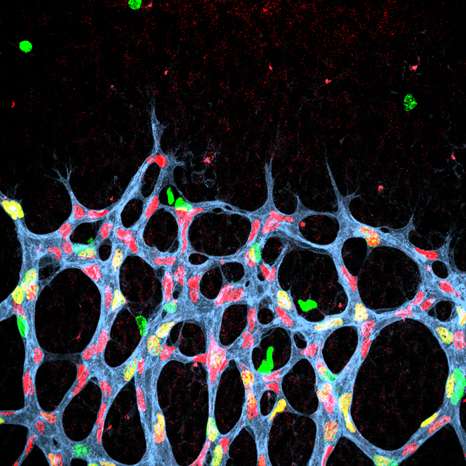Caring for blindness: A new protein in sight?

Vasoproliferative ocular diseases are responsible for sight loss in millions of people in the industrialised countries. Many patients do not currently respond to the treatment offered, which targets a specific factor, VEGF. A team of Inserm researchers at the Vision Institute (Inserm/CNRS/Pierre and Marie Curie University), in association with a team from the Yale Cardiovascular Research Center, have demonstrated in an animal model that blocking another protein, Slit2, prevents the pathological blood vessel development that causes these diseases. This work is published in Nature Medicine.
Vasoproliferative ocular diseases are the main cause of blindness in the industrialised countries. Age-related macular degeneration (ARMD), diabetic retinopathy and retinopathy of prematurity (in newborns) are characterised by progressive involvement of the retina, the area of the eye that receives visual information and transmits it to the brain. This damage is caused by abnormal growth of the blood vessels in the retina. These weakened vessels allow leakage of serum—which causes a swelling that lifts the retina—and/or blood, which leads to retinal haemorrhage.
This process involves several proteins required for normal or pathological development of the blood vessels. The action of vascular endothelial growth factor (VEGF) is a particularly decisive factor in this ocular disorder. At present, the main treatments are aimed at blocking its action by injecting inhibitors into the eye. Some patients are or become resistant to these anti-VEGF therapies.
For this reason, the team led by Alain Chédotal, in collaboration with a team led by Anne Eichmann , sought to identify new factors involved in the growth of new blood vessels, angiogenesis. They paid particular attention to Slit2.
Slit2 is a protein already known for its role in the development of neural connections. By acting on its receptors, Robo1 and Robo2, it is also involved in the development of many organs and certain cancers. The researchers therefore formulated the hypothesis that this factor might have a role in the abnormal vascularisation observed in vasoproliferative ocular diseases.
To test this postulate, the scientists inactivated Slit2 in a mouse model. They observed that ramification and growth of the retinal blood vessels were severely reduced, without any change in the stability of the pre-existing blood supply. Surprisingly, they discovered that without this protein, VEGF action was also partly reduced. By simultaneously blocking Robo1 and Robo2, they obtained the same results. They thus demonstrated that Slit2 is essential for angiogenesis in the retina.
"The success of these initial experiments led us to hope that controlling Slit2 might block the chaotic development of blood vessels in ocular diseases," explains Alain Chédotal, Inserm Research Director.
The team therefore repeated these tests in an animal model for retinopathy of prematurity. As they had suspected, the absence of Slit2 protein prevented abnormal vascularisation of the retina in these young mice.
This work suggests that therapies targeting Slit2 protein and its receptors, Robo1 and Robo2, might be beneficial for patients with vasoproliferative ocular disease, especially those who are resistant to conventional anti-VEGF therapies.
Moreover, it would be interesting to set up other studies to obtain a better understanding of the mechanism of action of Slit2 and its relationship with VEGF. This could open up new avenues for the treatment of tumours.
More information: Slit2 signaling through Robo1 and Robo2 is required for retinal neovascularization, dx.doi.org/10.1038/nm.3849
















